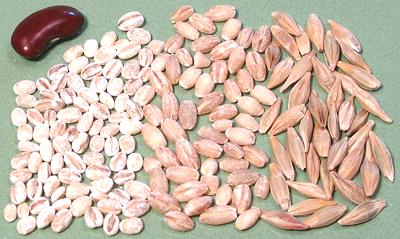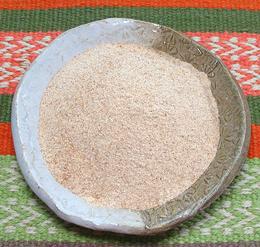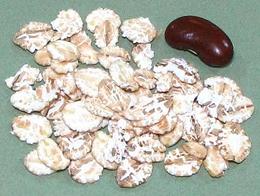 The photo to the left shows 2 row and 6 row Barley, heads as harvested.
Photo by Xianmin Chang contributed to the Public Domain
.
The photo to the left shows 2 row and 6 row Barley, heads as harvested.
Photo by Xianmin Chang contributed to the Public Domain
. [Damai (China); Hordeum vulgare]
[Damai (China); Hordeum vulgare]
Barley was first domesticated in the Near East with the earliest find being in Syria dated to around 7000 BCE. Beer has been made from it since about then. It has been grown in Korea from around 1400 BCE. Tibet started growing barley around 450 CE. Made into a toasted flour product called tsampa, it is still the most important staple in that region.
Barley comes in two varieties, two row and six row. The six row is higher in protein and used primarily as animal feed. The two row is higher in sugar and is used more for human consumption. Note that barley does contain the protein gluten, not enough to make leavened bread, but enough to harm a person with Celiac Disorder.
While it was an important staple in early cultures, the most important use for barley today is in the making of beer. Well, maybe actually it always has been - some archaeologists think agriculture was started mainly for reliable production of beer and wine. The earliest finds seem associated with ceremonial sites, wine presses and brewing equipment. English and German beers are made from malted two row barley. American beers were traditionally made from six row barley but both varieties are used today. Pardon me a moment - I have to refill my beer mug. There, that's better.
The photo shows barley as harvested on the right, hulled and very lightly pearled in the center, and to the left the heavily pearled form generally found in North American supermarkets.
More on Other Grains.
 The photo to the left shows 2 row and 6 row Barley, heads as harvested.
Photo by Xianmin Chang contributed to the Public Domain
.
The photo to the left shows 2 row and 6 row Barley, heads as harvested.
Photo by Xianmin Chang contributed to the Public Domain
.
 This is the most important staple of the Tibetan people - Barley that has
been soaked, dried just damp, roasted golden, and ground. We have a
recipe, Tsampa, for
making modest batches in a home kitchen.
This is the most important staple of the Tibetan people - Barley that has
been soaked, dried just damp, roasted golden, and ground. We have a
recipe, Tsampa, for
making modest batches in a home kitchen.
The traditional method of making Tsampa is a day long process, usually
starting with a 25 pound (or larger) bag of hulled Barley. It is soaked,
and roasted mixed with sand for even heating, then the sand is sieved out
before the barley is winnowed of chaff and ground.
 This product is made similarly to Rolled Oats, and used similarly as a
quick cooking cereal. To make these, whole hulled oats are steamed and
then rolled flat and lightly toasted to stabilize them. They are used
as a breakfast cereal, as a content in granola bars, etc.
This product is made similarly to Rolled Oats, and used similarly as a
quick cooking cereal. To make these, whole hulled oats are steamed and
then rolled flat and lightly toasted to stabilize them. They are used
as a breakfast cereal, as a content in granola bars, etc.